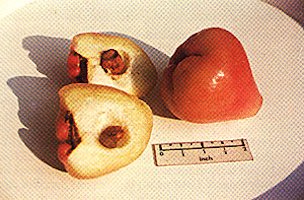From the book
Fruits of Warm Climates
by Julia F. Morton
Java Apple
Syzygium samarangense Merr. & Perry
Syzygium javanicum Miq.
Eugenia javanica Lam.
MYRTACEAE
Much less known than the Malay Apple, this member of the Myrtaceae
is botanically identified as Syzygium samarangense Merr. & Perry
(syns. S. javanicum Miq.; Eugenia javanica Lam. in part; E. alba
Roxb.). Among its various vernacular names are: samarang rose apple,
djamboe semarang (Indonesia); jambu ayer rhio (Malaya); pini jambu
(Ceylon);jumrool, jamrul, or amrool (India); chom pu kao, or chom pu
kio (Thailand); makopa (Philippines); cashu di Surinam, or Curacaose
appel (Curacao); wax apple, wax jambu and water apple, generally.

Plate LIII: JAVA APPLE, Syzygium samarangense
Description
The
tree, 16 to 50 ft (5-15 m) tall, has a short trunk 10 to 12 in (25-30
cm) thick, and open, widespreading crown, and pinkish-gray, flaking
bark. The opposite leaves are nearly sessile, elliptic-oblong, rounded
or slightly cordate at the base; yellowish to dark bluish-green; 4 to
10 in (10-25 cm) long and 2 to 4 3/4 in (5-12 cm) wide; very aromatic
when crushed. Flowers, borne in drooping panicles of 3 to 30 at the
branch tips or in smaller clusters in the axils of fallen leaves, are
fragrant, yellowish-white, 3/4 to 1 1/2 in (2-4 cm) broad, 4-petalled,
with numerous stamens 3/5 to 1 in (1.5-2.5 cm) long. The waxy fruit,
usually light-red, sometimes greenish-white or cream-colored, is
pear-shaped, narrow at the base, very broad, flattened, indented and
adorned with the 4 fleshy calyx lobes at the apex; 1 1/3 to 2 in (3.4-5
cm) long, 1 3/4 to 2 1/8 in (4.5-5.4 cm) wide. The skin is very thin,
the flesh white, spongy, dry to juicy, subacid and very bland in
flavor. There may be 1 or 2 somewhat rounded seeds 3/16 to 5/16 in
(0.5-0.8 cm) wide, or none.
Origin and Distribution
The
tree is indigenous from Malaya to the Andaman and Nicobar Islands where
there are wild trees in the coastal forests. It was introduced into the
Philippines in prehistoric times and is widely grown throughout those
islands. It is common in Thailand, Cambodia, Laos, Vietnam and Taiwan,
frequently cultivated in India and in Zanzibar and Pemba, but primarily
as an ornamental, seldom for its fruits which are little valued. It was
introduced into Jamaica before 1903 and also into Surinam and the
islands of Curacao, Aruba and Bonaire. A few trees have been grown in
Israel but have borne sparsely.
Climate
The
Java apple is extra-tropical, growing only at the lower
altitudes–up to 4,000 ft (1,220m)–in India. It does best in
parts of the Philippines that have a long dry season.
Soil
The soil must be fertile, or the crops will be small and the fruit quality poor.
Propagation
The
trees grow spontaneously from seed. Preferred types are reproduced by
layering, budding onto their own rootstocks, or onto seedlings of S.
densiflorum A. DC., (the beautiful Wild Rose Apple of Malaya, which has
edible flowers, undesirable fruits, but is not attacked by termites).
Sometimes the Java apple is grafted onto the cultivated Rose Apple
(q.v.).
Culture
If planted in orchards, the trees are spaced 26 to 32 ft (8-10 m) apart and are given a minimum of attention.
Season
In
Ceylon, the fruits are ripe from March to May; in India, the tree
blooms in March and April and the fruit ripens in May and June; in
Java, flowering occurs from April to June and fruiting from June to
August.
Yield
The Java apple is a heavy bearer on good soil. When 5 years old it may yield a crop of 700 fruits.
Food Uses
In
Malaya, the greenish fruits are eaten raw with salt or may be cooked as
a sauce. They are also stewed with true apples. The pink fruits are
juicier and more flavorful and suitable for eating out-of-hand or
cooking without accompaniments except sugar.
| Food
Value Per
100 g of Edible Portion* |
| Moisture |
91.40-92.96 g |
| Protein |
0.50 g |
| Sugar |
6.56 g |
| Iron |
0.001 g |
| Ash |
0.21-0.27 g |
| Calcium |
0.01 g |
| Phosphorus |
0.03 g |
| Sulphuric Acid |
0.17% |
| Citric Acid |
0.15% |
*Analyses made in the Philippines. |
|
Other Uses
Wood: The wood is red, coarse, hard; used for constructing huts in the Andaman and Nicobar Islands.
Medicinal Uses:
The flowers are astringent and used in Taiwan to treat fever and halt
diarrhea. Investigators have found their principal constituent to be
tannin. They also contain desmethoxymatteucinol, 5-O-methyl-4'-desmethoxymatteucinol, oleanic acid and B-sitosterol.
They show weak antibiotic action against Staphylococcus aureus,
Mycobacterium smegmatis, and Candida albicans.
|
|